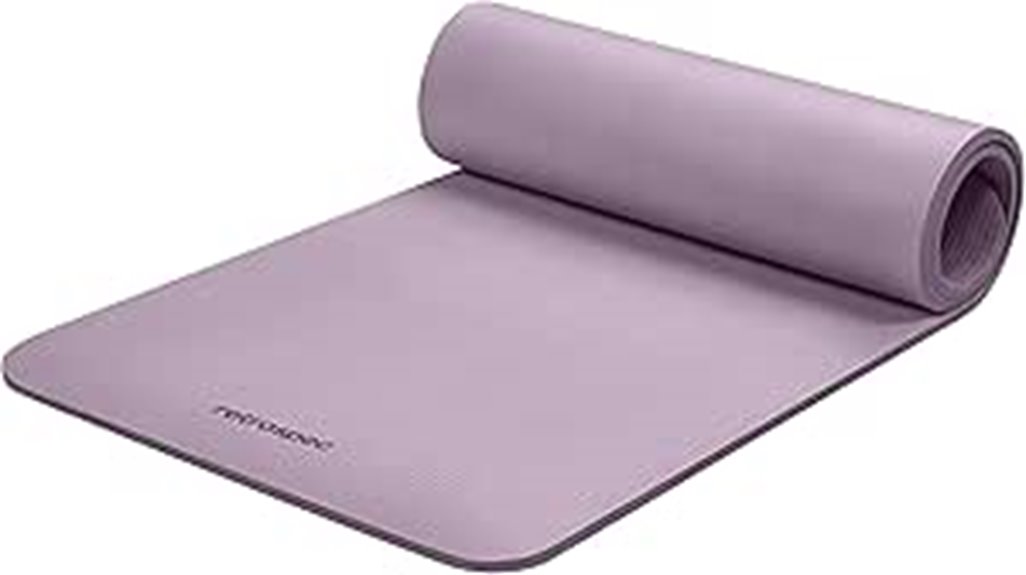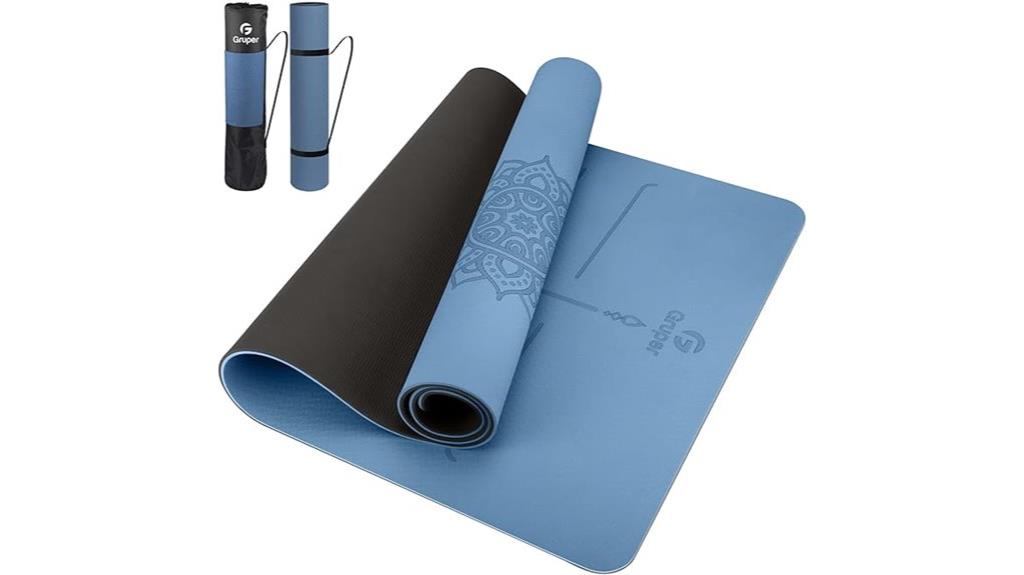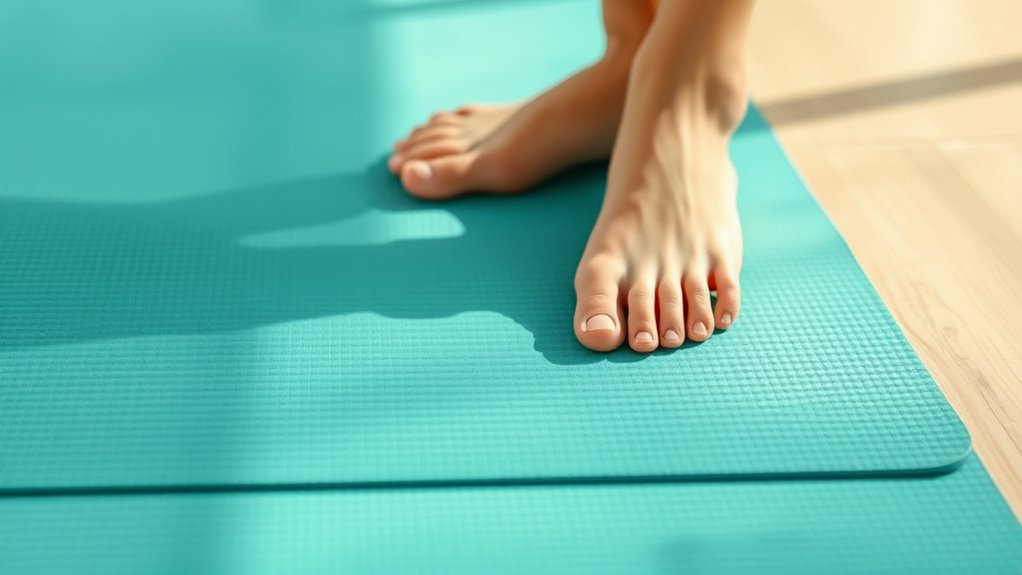If you’re looking for the best non-slip yoga mats for beginners in 2025, I recommend considering options like eco-friendly TPE and double-layer mats that offer great grip and durability. Thickness varies for comfort, from 1/2 inch to 1 inch, providing excellent joint support. Many come with carrying straps for easy transport. If you keep these factors in mind, you’ll find a perfect match, and there’s more to discover to help you choose wisely.
Key Takeaways
- Eco-friendly, high-density TPE and durable materials ensure safety, longevity, and a soft, skin-friendly surface.
- Upgraded textured, non-slip surfaces on both sides provide reliable grip during various yoga poses.
- Standard sizes like 72×24 inches and optional thicknesses offer ample space and comfort for beginners.
- Easy to clean and maintain, these mats resist wear and tear, ensuring long-term durability.
- Designed for barefoot use, they suit environmentally conscious users seeking safe, stable practice mats.
Yoga Mat Non Slip Eco Friendly Fitness Exercise Mat with Carrying Strap

If you’re new to yoga or fitness, the Yoga Mat Non Slip Eco Friendly Fitness Exercise Mat with Carrying Strap is an excellent choice because of its upgraded anti-slip textured surface on both sides. I love how it provides reliable grip during my routines, so I feel secure no matter how intense my moves get. Made from eco-friendly, softer materials than traditional mats, it’s safer for the environment and my skin. The durable double-layer design resists tearing and maintains its shape over time. Plus, with the included carrying strap, I can easily take it anywhere—whether at home, the gym, or outdoors.
Best For: beginners and eco-conscious individuals seeking a durable, non-slip yoga or fitness mat for versatile routines at home, gym, or outdoors.
Pros:
- Eco-friendly and softer material safer for skin and environment
- Upgraded anti-slip textured surface on both sides for reliable grip
- Double-layer design enhances durability, tear, and deformation resistance
Cons:
- May be too thick for those preferring a more minimal feel
- Not suitable for use with shoes or pet paws to prevent damage
- Requires careful cleaning with damp cloth; avoid machine washing
Retrospec Solana Yoga Mat with Nylon Strap

The Retrospec Solana Yoga Mat with Nylon Strap is an excellent choice for beginners seeking comfort and stability. Its 1/2-inch thickness cushions joints, hips, and knees during floor exercises, making each pose more comfortable and sustainable. The non-slip surface grips the floor well, helping you maintain your balance and stay focused on your form. Built to last, it withstands daily use and intense workouts, thanks to durable, BPA-free materials that prioritize your health. Plus, the included nylon strap makes it easy to roll up and carry, simplifying storage and transport. Cleaning is straightforward with just soap and water, keeping it fresh for repeated use.
Best For: Beginners and yoga practitioners seeking a comfortable, stable, and portable mat for home or studio use.
Pros:
- Cushions joints, hips, and knees for enhanced comfort during floor exercises
- Non-slip surface provides excellent grip for stability and safety
- Durable, BPA-free materials ensure longevity and health-conscious use
Cons:
- Thickness may be less suitable for high-intensity or standing workouts requiring more support
- May be bulkier to carry compared to thinner mats
- Requires regular cleaning to maintain grip and freshness
Retrospec Solana Yoga Mat 1/2in Non-Slip Exercise Mat

The Retrospec Solana Yoga Mat’s 1/2-inch thick cushioning makes it an excellent choice for beginners who want extra comfort during their workouts. I appreciate how it reduces joint, hip, and knee strain, making floor exercises more comfortable. Made from high-density TPE, it offers a non-slip surface that stays stable during challenging poses and high-intensity routines. The 72×24-inch size provides ample space, and the included nylon strap makes it easy to carry and store. Its durable, BPA-free design is simple to clean with soap and water, ensuring it stays fresh. Whether at home or in a studio, this mat supports my practice with dependable stability.
Best For: Beginners and intermediate users seeking a comfortable, stable, and versatile yoga or floor exercise mat for home, studio, or outdoor workouts.
Pros:
- Provides 1/2-inch thick cushioning to reduce joint, hip, and knee strain during workouts
- Made from durable, high-density TPE with a non-slip surface for stability during challenging poses
- Includes a nylon strap for easy carrying, storage, and portability
Cons:
- Weighs approximately 1.04 kg, which may be slightly heavy for some users to carry frequently
- No warranty is included with the product
- Limited color options (not specified beyond violet haze)
Retrospec Solana Yoga Mat with Nylon Strap

Designed with beginners in mind, the Retrospec Solana Yoga Mat offers 1-inch extra thickness that provides exceptional comfort and stability during practice. Its generous size—72 inches long and 24 inches wide—helps alleviate pressure on joints, hips, and knees during yoga, Pilates, or stretching. The non-slip surface guarantees secure footing on various floor types, preventing slips and injuries. Made from durable, eco-friendly materials, it’s built for daily use and can handle intense workouts. Plus, the included nylon strap makes it easy to carry between sessions, whether at home, studio, or gym. This mat combines comfort, safety, and portability perfectly for beginners.
Best For: Beginners seeking a comfortable, stable, and portable yoga mat suitable for various fitness routines and floor types.
Pros:
- Extra 1-inch thickness offers enhanced comfort and joint support
- Non-slip surface ensures secure footing during practice
- Includes a nylon strap for easy transport and convenience
Cons:
- May emit a harmless odor initially, requiring airing out before use
- Thicker design could be slightly heavier to carry over long distances
- Made from materials that should be kept clean and dry to maintain durability
Non-Slip TPE Yoga Mat with Alignment Mark and Carrying Strap

If you’re new to yoga or looking for a reliable mat that stays firmly in place, the Non-Slip TPE Yoga Mat with Alignment Mark and Carrying Strap is an excellent choice. Made from eco-friendly, non-toxic TPE material, it’s safe for beginners and athletes alike. The double-layer design boosts durability, while the sticky texture on both sides ensures excellent grip during practice. It’s available in standard and thicker options—perfect for protecting knees and reducing impact. The included alignment system helps me position my hands and feet accurately, improving posture and focus. Plus, the lightweight carry strap makes it easy to take this mat anywhere I practice.
Best For: beginners and athletes seeking a durable, eco-friendly yoga mat with reliable grip and alignment support.
Pros:
- Made from non-toxic, odorless TPE material that is safe and eco-friendly
- Double-layer structure enhances durability and tear resistance
- Includes alignment system to improve posture and practice precision
Cons:
- Requires careful cleaning with a damp cloth; not machine washable
- Avoid prolonged sun exposure to prevent material damage
- Designed for barefoot exercises; shoes or pet paws may cause wear
Factors to Consider When Choosing a Yoga Mat for Beginners Non Slip

When choosing a non-slip yoga mat, I look closely at the surface quality to guarantee it provides good grip. I also consider the thickness for comfort and whether the material is eco-friendly, durable, and easy to carry. These factors help me find a mat that’s safe, practical, and sustainable for my practice.
Non-Slip Surface Quality
A high-quality non-slip surface is essential for maintaining stability and preventing slips during your yoga practice. A textured surface with sticky or textured patterns markedly improves grip, especially on different floor types. Dual-sided textured mats provide enhanced traction on both sides, increasing safety during various exercises. Materials like TPE and eco-friendly rubber are designed with non-slip properties that stay effective even when you’re sweaty, guaranteeing consistent grip. The durability of the surface also matters; a long-lasting non-slip layer maintains traction over time, reducing the risk of accidents. When choosing a mat, look for these features to ensure reliable grip throughout your practice. A well-made non-slip surface helps you focus on your poses without fearing slips, making your yoga journey safer and more enjoyable.
Cushioning Thickness Options
Choosing the right cushioning thickness for your yoga mat is essential because it directly impacts your comfort, stability, and safety during practice. Thicker mats, around 6-8mm, provide more cushioning, reducing pressure on your joints and making poses more comfortable, especially for high-impact routines. On the other hand, thinner mats, about 3mm or less, offer increased stability and a closer connection to the ground, which helps improve balance and control—ideal for balance-focused practices. However, overly thick mats can compromise stability, making it harder to hold certain poses, especially for beginners still developing their balance. Ultimately, your choice depends on personal comfort, your body’s needs, and the type of yoga or exercise you plan to do regularly.
Material Eco-Friendliness
Eco-friendly yoga mats are made from sustainable materials like TPE, natural rubber, or recycled rubber, which help reduce environmental impact. These mats are free from harmful chemicals such as phthalates, heavy metals, and latex, making them safer for skin contact and overall health. Choosing an eco-conscious mat often means supporting brands that prioritize biodegradable, non-toxic, and recyclable materials, aligning with a sustainable lifestyle. Additionally, eco-friendly mats typically have a lower carbon footprint during manufacturing compared to traditional PVC or EVA options. Many are crafted with plant-based dyes and packaged in recycled or biodegradable materials, further minimizing environmental harm. By selecting a mat made from these sustainable materials, I can practice with peace of mind, knowing I’m reducing my ecological footprint while enjoying a safe, non-slip surface.
Size and Portability
Have you considered how the size and portability of a yoga mat can impact your practice? A mat at least 68 inches long ensures comfort, especially if you’re taller or like extra space. Choose a lightweight option, ideally under 3 pounds, so you can easily carry it to classes or outdoor sessions. Mats with carrying straps or bags make transportation even more convenient. When it comes to thickness, around 6-8mm strikes a good balance between cushioning and stability, helping you maintain proper postures. Also, select a size and design that rolls up easily without bulk, so setup and pack-up are quick. Prioritizing portability means you’ll be more likely to stick with your practice, wherever you prefer to do yoga.
Durability and Tear Resistance
Since durability is essential for ensuring your yoga mat lasts through regular use, I recommend paying attention to its construction and material quality. A double-layer design can markedly improve tear resistance, helping the mat hold up over time. High-quality mats made from eco-friendly materials like TPE or thick PVC tend to be more resistant to tearing and deformation. Thicker mats, such as those 6mm or more, also provide better durability and cushioning, especially for frequent practice. To keep your mat in top shape, choose one with textured, non-slip surfaces on both sides, which helps prevent wear and maintains grip during intense sessions. Regularly inspecting your mat for signs of wear can prevent accidents caused by compromised tear resistance, ensuring safety and longevity.
Maintenance and Cleaning
Maintaining your yoga mat’s cleanliness is essential for both hygiene and safety during practice. I recommend regularly wiping it down with a damp cloth and mild detergent to keep dirt and sweat at bay, which helps preserve its grip. Avoid harsh chemicals or abrasive cleaners, as they can damage the surface and diminish the non-slip features. After cleaning, make sure to air dry your mat completely before rolling it up; this prevents mold and odors from developing. When not in use, store it in a cool, dry place away from direct sunlight to prolong its lifespan and prevent material breakdown. For deep cleaning, some mats can be washed with gentle soap and water—just always check manufacturer instructions to avoid voiding warranties. Proper maintenance keeps your mat safe and effective over time.
Price and Value
Choosing the right yoga mat for beginners involves balancing price and quality to get the best value. Budget-friendly mats usually cost between $15 and $30, providing basic non-slip features that suit new yogis. However, investing a bit more—around $30 to $50—often means better durability and grip, making the mat last longer and perform better over time. Cheaper mats tend to wear out quickly or lose their grip, which can compromise safety and require replacement sooner. To get the best value, look for mats that combine affordability with quality features like textured surfaces and eco-friendly materials. Reading customer reviews can also help determine if a lower-priced option still offers good performance and durability, ensuring you don’t sacrifice quality for savings.
Additional Features
When selecting a non-slip yoga mat for beginners, paying attention to additional features can make a significant difference in your practice. Alignment marks are helpful for maintaining proper posture, especially when learning new poses. Carrying straps and storage bags boost portability, so you can take your mat anywhere easily. Extra cushioning options provide better joint support and comfort, reducing fatigue during longer sessions. Non-slip textured surfaces on both sides enhance safety by minimizing the risk of slipping, even during sweaty practices. Additionally, choosing mats made from eco-friendly, non-toxic materials guarantees a healthier environment for your practice and peace of mind. These features collectively improve comfort, safety, and convenience, making your yoga journey smoother and more enjoyable.
Frequently Asked Questions
Are Non-Slip Yoga Mats Suitable for Hot Yoga Sessions?
Yes, non-slip yoga mats are perfect for hot yoga sessions. I find they provide excellent grip even when I sweat, preventing slips and injuries. The textured surface helps me stay stable during challenging poses, and many mats are designed to absorb moisture effectively. So, if you’re practicing hot yoga, I definitely recommend a good non-slip mat to keep you safe and focused throughout your practice.
How Often Should I Replace My Beginner Yoga Mat?
I usually replace my beginner yoga mat every 6 to 12 months, depending on how often I practice and its condition. If I notice significant wear, tears, or loss of grip, I upgrade sooner. Regular cleaning helps extend its life, but when it starts to feel slippery or uncomfortable, it’s time for a new one. Trust your instincts—if your mat isn’t supporting your practice, it’s time for a change.
Can Eco-Friendly Mats Provide the Same Grip as Synthetic Ones?
Eco-friendly mats can absolutely provide the same grip as synthetic ones. I’ve tried both, and a bamboo-based mat I used last year offered excellent traction, even during sweaty sessions. The key is choosing mats made from natural rubber or jute, which naturally grip the floor and your hands, just like synthetic options. So, don’t worry—going green doesn’t mean sacrificing safety or stability in your practice.
Are Lightweight Mats Durable for Regular Practice?
Yes, lightweight mats can be durable for regular practice if you choose the right one. I’ve found that high-quality materials like TPE or natural rubber provide both lightness and resilience. They stand up well to frequent use and offer good grip without adding bulk. Just make sure to read reviews and pick a mat with a solid reputation for durability. With proper care, your lightweight mat can last for years of consistent practice.
Do Non-Slip Mats Work Well on All Floor Types?
Yes, non-slip mats work well on most floor types, but their effectiveness varies. I’ve found they grip hardwood, tile, and concrete floors reliably, providing stability. However, on carpeted surfaces, some mats might slip more, especially if the pile’s thick. To guarantee safety, I recommend checking the mat’s grip on your specific floor type and considering a textured surface or additional grip solutions if needed.
Conclusion
So, as you select your perfect non-slip yoga mat, remember to prioritize grip, grace, and green goodness. By balancing benefits and boundaries, you’ll build confidence, comfort, and consistency on your journey. With the right mat in hand, you’ll harness harmony, heighten your health, and happily hop into each session. Stay steady, stay strong, and let your practice flourish on a foundation that feels fantastic and functions flawlessly.










